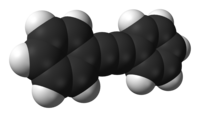Diphenylacetylene

| |

| |

| |
| Names | |
|---|---|
| Preferred IUPAC name
1,1′-Ethynediyldibenzene | |
| Other names
Tolane
1,2-Diphenylethyne Diphenylethyne 2-Phenylethynylbenzene Tolan | |
| Identifiers | |
3D model (
JSmol ) |
|
| 606478 | |
| ChEBI | |
| ChEMBL | |
| ChemSpider | |
ECHA InfoCard
|
100.007.206 |
| EC Number |
|
PubChem CID
|
|
| UNII | |
CompTox Dashboard (EPA)
|
|
| |
| |
| Properties | |
| C14H10 | |
| Molar mass | 178.234 g·mol−1 |
| Appearance | Colorless solid |
| Density | 1.136 g cm−3[1] |
| Melting point | 62.5 °C (144.5 °F; 335.6 K) |
| Boiling point | 170 °C (338 °F; 443 K) at 19 mmHg |
| Insoluble | |
| Structure | |
| 0 D | |
| Hazards | |
| Safety data sheet (SDS) | Fisher Scientific MSDS |
| Related compounds | |
Related compounds
|
But-2-yne
Dimethyl acetylenedicarboxylate |
Except where otherwise noted, data are given for materials in their standard state (at 25 °C [77 °F], 100 kPa).
| |
Diphenylacetylene is the
phenyl groups attached to a C2 unit. A colorless solid, it is used as a building block in organic synthesis and as a ligand in organometallic chemistry
.
Preparation and structure
In one preparation for this compound,
Castro-Stephens coupling. The related Sonogashira coupling involves the coupling of iodobenzene and phenylacetylene
.
Diphenylacetylene is a planar molecule. The central C≡C distance is 119.8 picometers.[1]
Derivatives
Reaction of diphenylacetylene with tetraphenylcyclopentadienone results in the formation of hexaphenylbenzene in a Diels–Alder reaction.[4]
Dicobalt octacarbonyl catalyzes alkyne trimerisation of diphenylacetylene to form hexaphenylbenzene.[5]
Reaction of Ph2C2 with
cyclopropenium bromide after the elimination of tert-butoxide.[6]
References
- ^ .
- .
- .
- .
- .
- .


